Posted by Filiberto Boncompagni on 01-27-2004 11:36 AM:
Rosati and the "Aleppo Kilims"
You already saw these two Rosati’s paintings
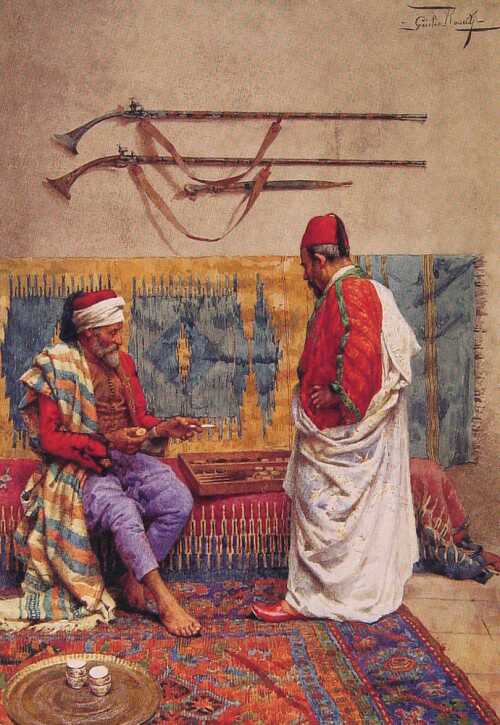

The idea for this Salon started with this picture from a
John Howe’s Show and tell Thread, "Gayle Garrett on Turkish Rugs at the TM".
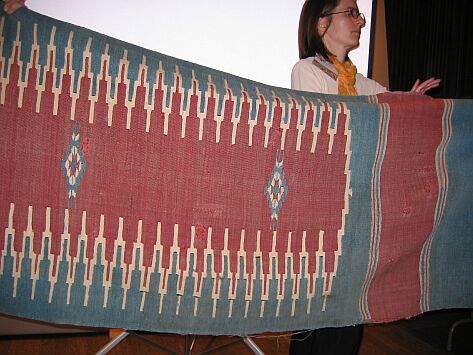
I
recognized the design. As it turned out, the two kilims in the first Rosati’s
watercolor and the one on the lower right part of the second painting are of the
same family. During the discussion Michael Wendorf identified them as "Aleppo
Kilims". That thread will be probably deleted and I’ll copy here some of the
pertinent considerations and related pictures.
Muammer Ucar confirmed
Wendorf’s opinion and sent a photo of another Aleppo Kilim:
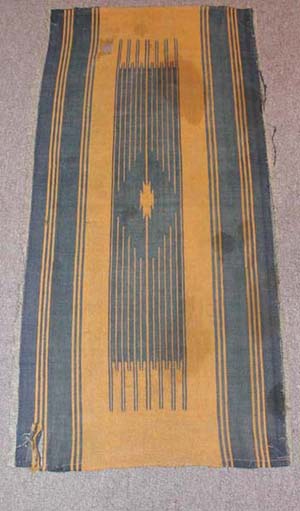
Since the Show and Tell kilim
was first attributed to Turkey and Aleppo is in Syria, John Howe explained the
apparent contradiction quoting Peter Stone's entry for "Aleppo" :
"A city of
northwest Syria, now called Haleb. It was formerly in southeast Anatolia and an
administrative center during the Ottoman period. In the last half of the
nineteenth century many kilims were woven in this area. They were used as
curtains and wall hangings. These kilims were woven in two pieces. Cochineal was
used in many of these kilims. Borders are usually white with a repeated winged
or hourglass figure. Diamonds and octagons are the primary repeated field motif.
Some of the kilims were woven with the sankikli or compartment
motif."
John quoted also Petsopoulos from his "Kilim," (1979):
Petsopoulos also indicates that Aleppo kilims often have "reciprocal" borders
and he shows three versions, one of which is similar to that on Gayle's piece
here… Petsopoulos also remarks on the use of cochineal in Aleppo
pieces…
Vincent Keers insisted that the weavers of this kind of
kilims were Kurds - a great part of the Syrian Kurds living near Aleppo -
quoting the Library of Congress.
A lot of space was devoted to "railway
stations" labeling 
Finally,
Louis Debreuil contributed with same interesting considerations and
pictures.
I’ll copy and paste them here:
miss Garret's
mysterious kilim
I've got one of these kilims and you can see the
pictures. This is an old one with indigo field and purple border. The warp is in
cotton with very fine threads.
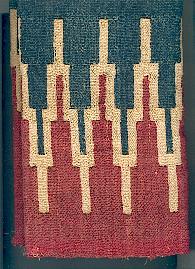
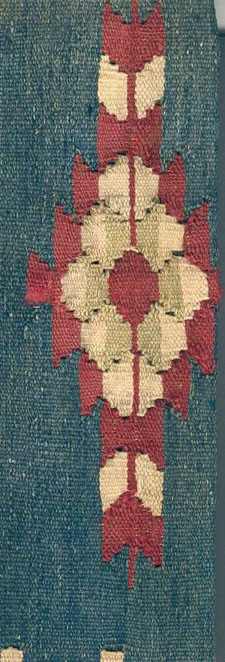
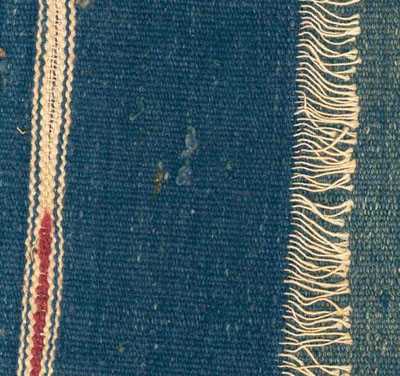
I have also a picture from a french book about Mauresques
(oriental females in the colonial photography 1860/1910) Christelle Taraud
(ALBIN MICHEL, ed).
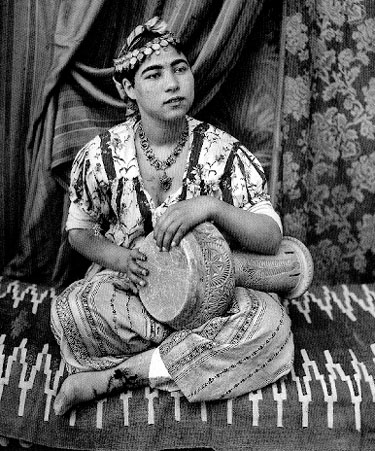
The picture is about 1890 and shows a young Tunisian musician.
She is seated on a kilim of the same type. It is probable that this type of
cloth in Tunisia could come from Aleppo better than Turkey. It is also possible
that it could be a mass produced article appreciated because its fashionable
look.
Meanwhile the pattern seems to be originated from Anatolia as it
can be seen on the last Hali (N° 132 page 53) with the yellow and red kilim from
the Stobe collection.
Best regards
Louis
Dubreuil
Thanks Louis, very interesting, especially the Tunisian
musician's photo.
Regards,
Filiberto
Posted by Louis Dubreuil on 01-30-2004 12:36 PM:
ROSATI KILIM
Bonsoir Filiberto
We need to identify the location of the Rosati
paintings. A trail for that is to identify the other rugs on the paintings. The
clothes of the figures could be also studied in order to find the
country.
But it is possible that Rosati made some "pot pourri" with different
photos and rugs. For the rugs I am not an expert of these types, beeing more
turkomaniac/kilimaniac/berbermaniac.
Amicalement
Louis
Posted by Filiberto Boncompagni on 01-31-2004 05:29 AM:
Dear Louis,
The identification of the rugs cannot help in finding the
location, I’m afraid
First: rugs are exported to other countries.
Second:
a decent rug seller is supposed to offer rugs of different variety and
provenance.
I’m not able to pinpoint the costumes to a specific country
either.
The only thing I noticed is that the two characters in the first
painting are the carpet sellers in the second, and their clothes are almost the
same.
Regards,
Filiberto
Posted by Louis_Dubreuil on 02-02-2004 08:36 AM:
Bonsoir Filiberto
Here are some photos from the book to post in the
salon "orientalist..." at the place you want.
These pictures are from a big
fund (700000 photos !) , the collection Ferrier-Soulier, Léon et lévy, Neurdein
Frères et Compagnie des Arts Photomécaniques.
This collection has been
purchased by the Roger Villet collection in 1970. Those photos cover a period
between 1860 and first part of the XX°.
Some of these pictures have been
used to illustrate a book "MAURESQUES" pictures of oriental women in the
colonial photography (1860/1910) by Christelle Taraud (Albin Michel ed, ISBN 2
226 140743, october 2003).
The first picture represents a young tunisian
woman lying on a sofa covered with a local rug (to be determined)
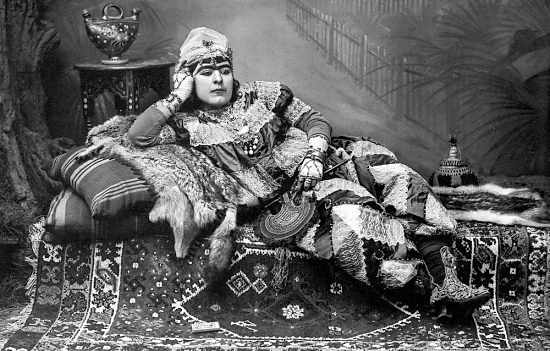
The second
picture represents a young algerian woman of the Tlemcen region lying on a sofa
covered with local handwoven clothes (to be determined)
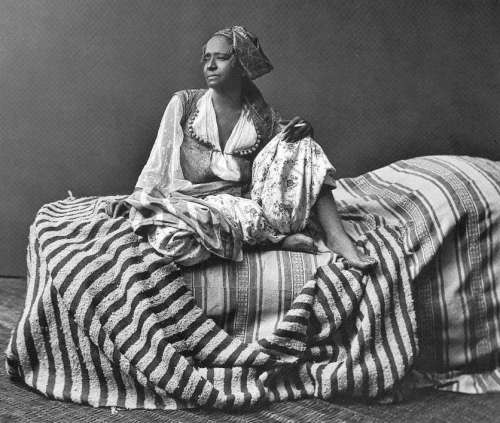
The third picture
represents a young algerian woman in the salon of her house in the Biskra
region. The three sofas are covered with non local rugs (to be determined)
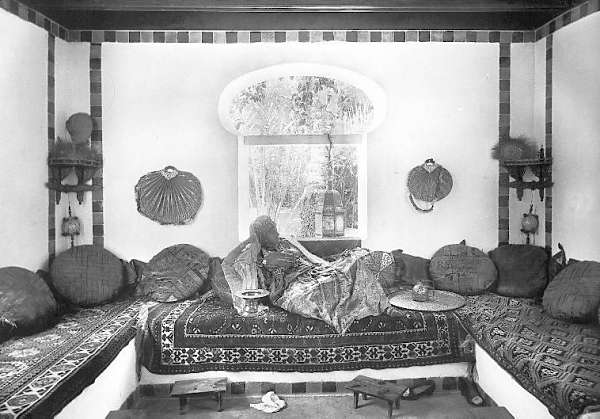
The fourth picture represents a young algerian woman in her
interior. On the floor we can see a coarse local rug and under the sofa what it
seems to be a local matting made of palm tree leaves embroidered with wool.
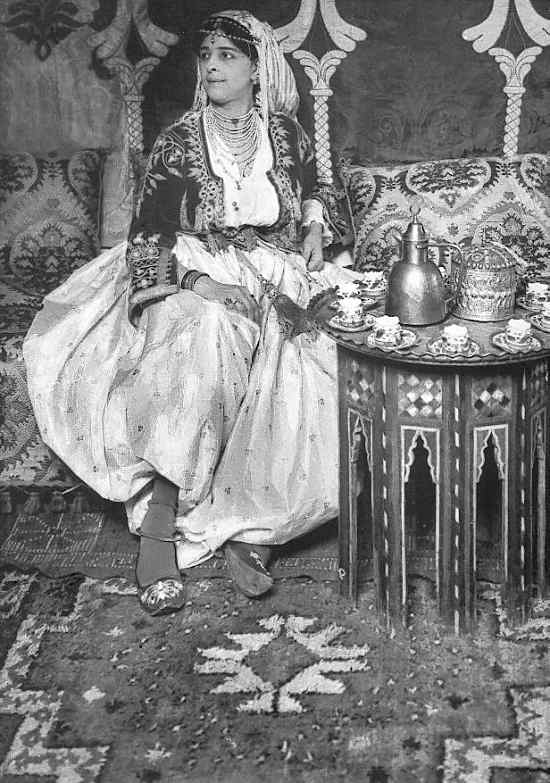
The fifth picture represents a young algerian woman on a
sofa with local hand woven striped clothes.
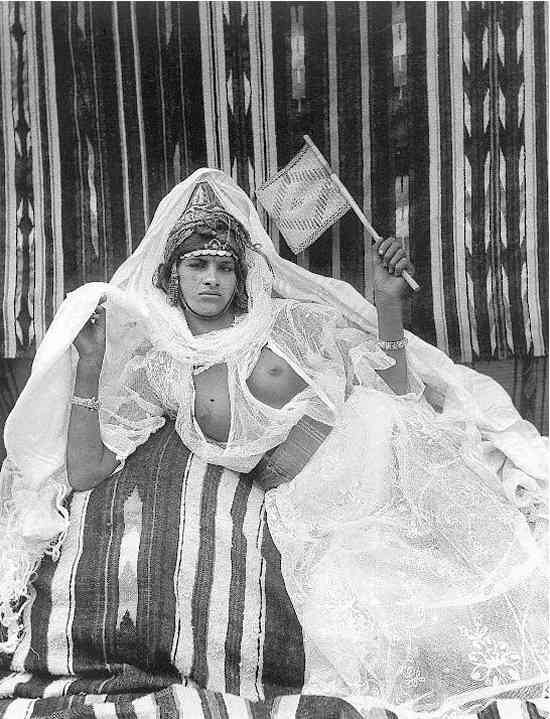
The sixth picture
represents a group of algerian women making couscous with a hand millstone and
spining wool on a big matting made of palm tree leaves and embroidered with
wool.
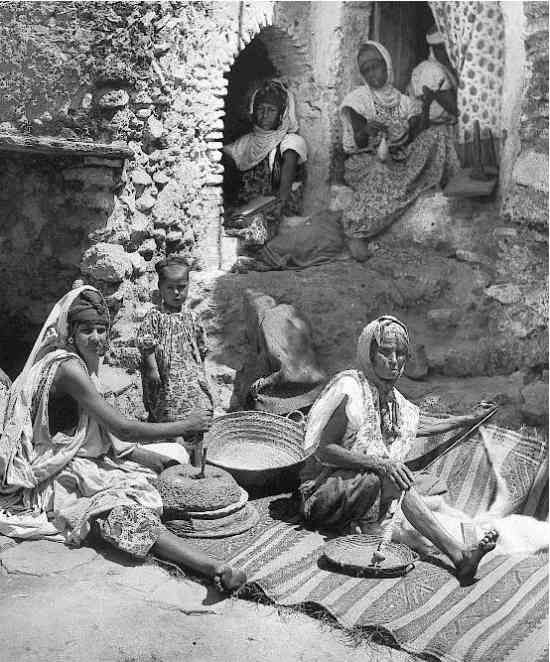
Avec mes amicales salutations.
Posted by Filiberto Boncompagni on 02-02-2004 10:15 AM:
Thank you Louis,
Interesting pictures. Especially one…
Well, hum,
let’s see the third picture, now.
quote:
The third picture represents a young algerian woman in the salon of her house
in the Biskra region. The three sofas are covered with non local rugs (to be
determined)
The left one is familiar:
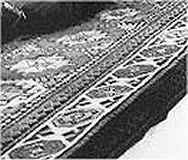
I see some rather
omnipresent (in the Rugdom) Memling guls, a medachyl minor border and the
"conjoined octagons" border like this one, detail of Bennett’s plate 151, Gendje
rug:
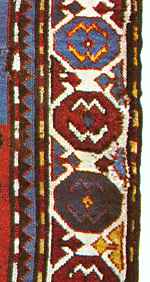
This is a Caucasian rug.
Regards,
Filiberto
Posted by David R.E. Hunt on 02-02-2004 10:25 PM:
Ladies?
All- You do realize that this region during this time frame,and especially
Tangier, represented the Amsterdam of this period and replete with all the
requisite diversions. I would suggest that these ladies, save photo#6, and most
definately #5-are shall we say fallen women. Most the weavings, save for maybe
photo#3, I believe could be local. Lots of striped designs here- and really like
the flatweave in the last photo. I've seen reed screens(well, at least plastic
imitation reed) used in Morocco too.- Dave
Posted by Filiberto Boncompagni on 02-03-2004 03:01 AM:
Hi David,
Actually one has to consider that making portrait (painted
or photographic) in the Middle East comported a few difficulties.
I’ll quote
here some observation on the subject from this very interesting web
site:"Orientalist Art of the Nineteenth Century"
http://www.orientalistart.net/Page5.html
Everyone
loved to paint prostitutes. You can see by the broken lattice work in the top
left of the painting that this wasn't the best part of town.
How hard was it
to paint people in the Middle East? It varied. The artist Henri Regnault was
befriended by a Moroccan girl named Aischa Chamma who convinced Muslim women to
pose for him. Chasseriau was able to paint Jewish subjects more easily but
William Holman Hunt had to get the local rabbi's permission before he could
paint any Jewish subjects for his famous painting, 'The finding of the Savior in
the Temple.'
Sometimes artists were shot at or confronted in the streets by
angry mobs. On the other hand the Shah of Iran sat for his portrait by Jules
Laurens and discussed art with him and Mohammad Ali, the Pasha of Egypt, allowed
David Wilkie to paint him. The Turkish painter, Osman Hamdi Bey, studied with
Gerome and founded both the first painting academy and archeological institute
in Istanbul
Regards,
Filiberto
P.S. And why they call Morocco
"Middle East" while it’s more to the West than most of Europe, it’s above
me…
Posted by Horst Nitz on 02-03-2004 04:41 PM:
Hallo everybody,
I have said good night to my tax declaration and went
for a little stroll throught Turkotek (much preferred).
It surprises me
you seem to have settled for an Aleppo attribution of the kilim in question and
that Petsopoulos, Yanni (1979) is cited as a reference. The colours of the
Aleppo kilims in Yanni’s book follow a much different schema and the reciprocal
element in the field-border separation shows only faint resemblance. Is there
other evidence or are we after a red herring named
Aleppo?
Yours,
Horst Nitz
Posted by R. John Howe on 02-03-2004 09:12 PM:
Horst -
I don't disagree with you that the kilims Petsopoulos offers
as "Aleppo" are quite different from the one Gayle Garrett had.
The only
actual references made to Petsopoulos above were to indicate that he says Aleppo
kilims have reciprocal borders and offers one of three that seems of the
approximate type in Gayle's piece. It was also noted that he cites the presence
of cochineal in Aleppo kilims, something others have noticed too.
I think
the original estimates that Gayle Garrett's kilim is likely made in Aleppo did
not cite Petsopoulos at all (see Michael Wendorf's comment
above).
Regards,
R. John Howe
Posted by Louis Dubreuil on 02-05-2004 04:37 PM:
Bonsoir Filiberto et tous les autres,
Here are two new pictures about
the Rosati kilim.
The first one is from a little book KILIM CATALOGUE N°1,
author Mr Erbek (I bought it at Istambul some years ago). the kilim is from the
Vakiflar Hali Museum collections. The border shows the typical reciprocated
Rosati pattern.
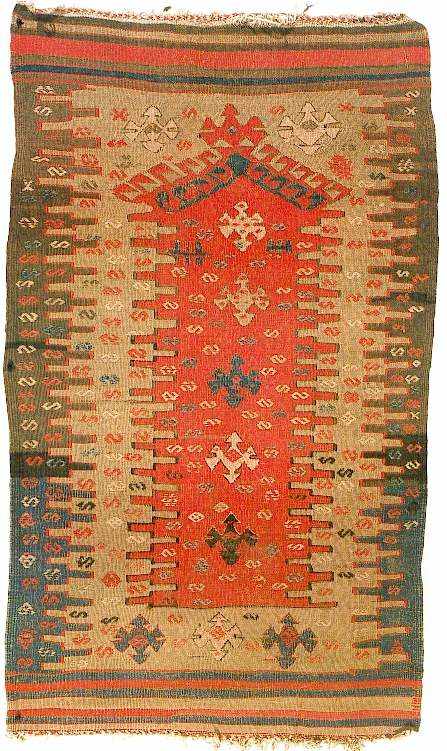
The second picture is more curious.
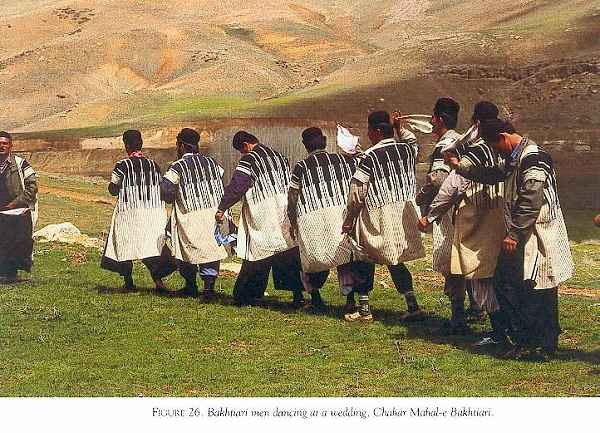
It is from the Parviz
Tanavoli's book PERSIAN FLATWEAVES. This pîcture shows a group of Bakhtiari men
with "Rosati kilim design coats". I called this : "walking Rosati's
kilims".
This picture shows that we can find our motif certainly out of
Anatolia, but under slightly modified shapes.
Bonsoir à
tous
Louis Dubreuil



















